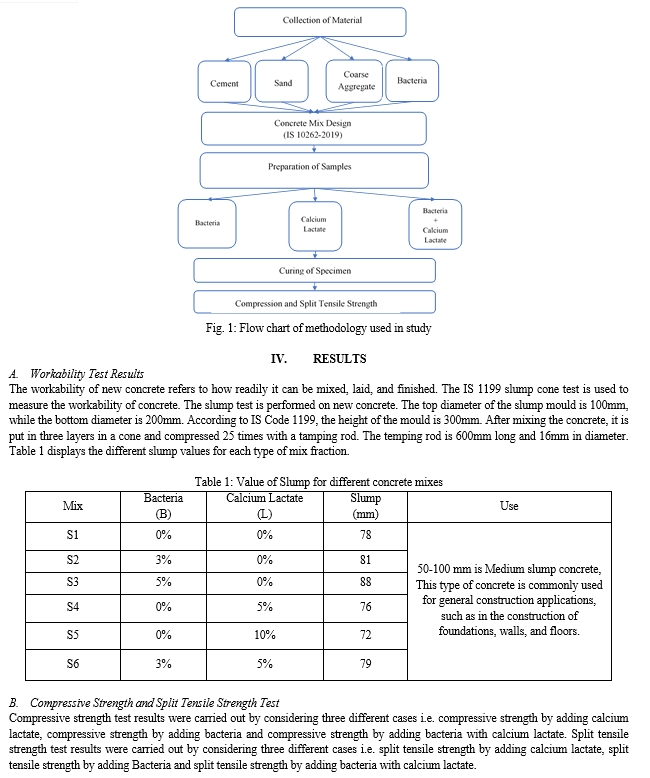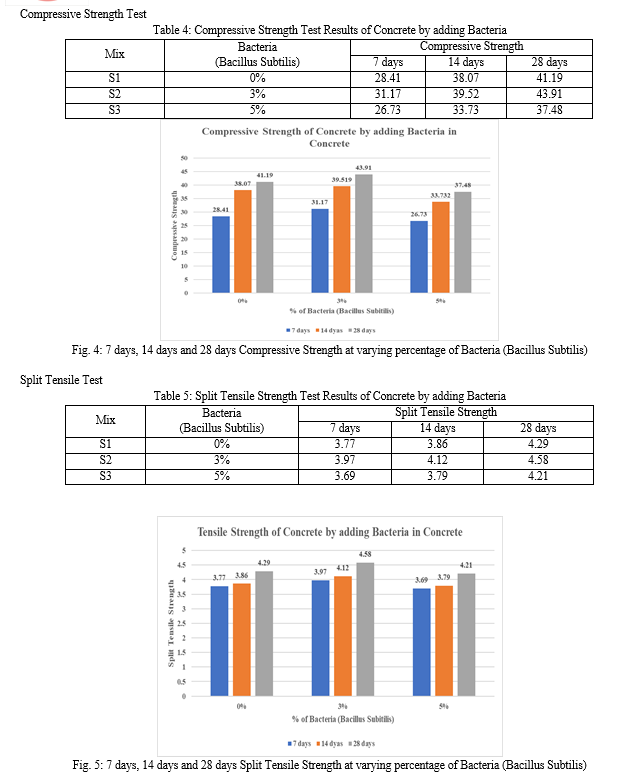Ijraset Journal For Research in Applied Science and Engineering Technology
- Home / Ijraset
- On This Page
- Abstract
- Introduction
- Conclusion
- References
- Copyright
Experimental Study on Bacterial based Self-Healing Concrete
Authors: Vaidik Sharma, Prof. Mayur Singi
DOI Link: https://doi.org/10.22214/ijraset.2023.54587
Certificate: View Certificate
Abstract
The potential of concrete to self-heal has been studied in several works, hence in this study we are analyzing the strength properties of self-healing bacterial concrete by mixing bacteria (Bacillus Subtilis) with calcium source. In the study, bacteria (Bacillus Subtilis) were introduced at 3% and 5%, while calcium lactate was added at 5% and 10%, respectively. As a result, the study addresses economic issues not just for building but also for upkeep. The purpose of this experiment was to look into the strength qualities of bacterial self-healing concrete with varied ratios of Bacillus subtilis and calcium lactate. The researchers prepared concrete specimens with varied ratios of bacterial solution and calcium lactate and tested their compressive and flexural strength. The results revealed that adding Bacillus subtilis and calcium lactate to the concrete enhanced its compressive and flexural strength, with the maximum strength values recorded at a 3% bacterial solution and 5% calcium lactate combination. Furthermore, the concrete\\\'s self-healing potential was assessed by putting the samples to crack-healing experiments. The results demonstrated that the bacterial self-healing concrete containing Bacillus subtilis and calcium lactate performed better than the control samples without bacteria. The study reveals that using Bacillus subtilis and calcium lactate in concrete might increase the material\\\'s strength and self-healing capabilities, leading to enhanced durability and sustainability of concrete buildings.
Introduction
I. INTRODUCTION
Self-healing Concrete is well-known for its ability to self-heal. Concrete's ability to self-heal or self-repair enables crack rectification and repair using either autonomous or autogenous processes. All of these techniques are distinguished by concrete's durability, which is one of its characteristics. Concrete's materialistic durability aids in its resistance to chemical or physical dangers. The chance of fracture development increases as durability deteriorates.
There are several solutions available for this typical structural cracking issue, both before and after the fracture. Self-healing or bacterial concrete is one of the repair procedures. Self-Healing Concrete is a type of concrete that, after hardening, may repair or fill gaps on its own owing to a bacterial response. Small cracks in a structure with a width of 0.05 to 0.1mm can be seen to be entirely sealed by repeating dry and wet cycles. More repair work is necessary when the cracks are bigger. Acid-producing bacteria are employed to promote spontaneous fracture healing. These bacteria may live in latent cells for more than 200 years in dry conditions. These bacteria speed fracture healing.
Concrete structures have a lifespan of 50-100 years. However, degradation of the building begins within 10 years of construction, and in some cases within a year. After a certain number of years, little cracks in the framework emerge, which might be structural or superficial.
"Bacteria-based Self-Healing Concrete" is a new approach to coping with concrete cracks. To fix fractures, the self-healing concrete employs a special strain of bacteria from the genus Bacillus as well as a calcium-based nutrition. Bacteria may survive in concrete for up to 200 years. When a fracture occurs and water penetrates into the crack, dormant bacteria become active and convert calcium lactate to limestone.
Self-healing concrete is created by a biological interaction between unreacted limestone and a calcium-based diet, with the help of bacteria, to cure building flaws. Bacillus bacteria are used in conjunction with the calcium supplement calcium lactate. These components are added to the wet concrete after the mixing process has been completed. The bacteria's spores begin to multiply and feed on the calcium lactate, consuming oxygen. Limestone is made up of soluble calcium lactate. The insoluble limestone begins to solidify.
As a result, the crack fills naturally without the need for outside aid. Another advantage of this technique is that the bacteria prevent steel from corroding due to fractures by eating oxygen while turning calcium into limestone. This boosts the durability of the steel-reinforced concrete structure.
II. LITERATURE REVIEW
Various studies and research have been conducted on bacterial self-healing concrete, as well as workability and strength of the concrete. The following research are available to assess the qualities of concrete based on Bacteria, or self-healing concrete, to determine the behaviour and properties of self-healing concrete.
(Abishek Kumar A. A 2020), Self-healing concrete was created for the study, and bacteria were added in amounts of 5ml, 10ml, and 15ml. According to the research, introducing 10ml of bacteria delivers the best results.
A 10ml increase in bacteria strength is seen. There is a 4.8% increase in 7-day strength, a 12.21% increase in 14-day strength, and a 1.33% increase in 28-day strength when compared to regular concrete. Similarly, split tensile strength was examined, and the findings show a 7%, 4.21%, and 10% increase after 7 days, 14 days, and 28 days, respectively. Water absorption was seen in these samples as well.
In a 10ml bacterial sample, water absorption was reduced by 9.72%.
(Aditya Tadimeti 2020), In this work, several polymers were used with bacillus subtilis in various aquatic situations. Bacillus subtilis can digest polythene in fresh water, however the degree of breakdown decreases when the water becomes saline or in saline water. ABS and HIPS plastics, on the other hand, were unaffected. As a result, they can be used with Bacillus subtilis. Bacillus subtilis use lowers polythene waste.
Bacillus can be used to minimise polythene waste, however additional literature and research are needed to understand more about the aquatic environment. As a result, waste in the water can also be degraded.
(C. Manvith Kumar Reddy 2020), In this investigation, bacteria at a concentration of 107 cells/ml are used, along with a calcium supply. As a calcium source, calcium lactate was used. Flexural strength of the concrete was examined. Flexural strength increased after bacteria and calcium lactate were added.
A maximum increase of 4% is anticipated. The research also examined the healing time and the length of the fracture. This reveals that bacterial concrete cures quicker than regular concrete and can treat fractures up to 100m long.
(Mors and Jonker 2019), The research was conducted as part of the Material for Life (M4L) project. This research programme looked at four different self-healing concrete technologies.
Examples include sodium silicate microcapsules, porous aggregates containing microorganisms, shape memory polymers, and mineral healing agents. The findings show that fracture breadth and permeability decrease over time. An ultrasonic pulse velocity metre, as well as an optical camera and microscope, are used to measure the fluctuation in crack width. The findings show that sodium silicate-based capsules outperform others in terms of repairing cracks longer than 100m.
(S.Dinesh 2017), When compared to standard concrete, the addition of bacteria boosted the compressive and tensile strengths while reduced permeability, water absorption, and reinforcement corrosion. Bacterial concrete increases the durability of structures by mending structural cracks.
The term "Smart Bio material" also refers to bacterial concrete because to its intrinsic capacity to precipitate calcite continuously. This material has been proved to be superior to traditional concrete since it is environmentally friendly and self-healing. Bacterial concrete will be manufactured in the near future for the construction of long-lasting, low-cost, and environmentally friendly high-quality structures. It is viable to employ since it will be more effective monetarily and practically because it necessitates expert work.
(Kunamineni Vijay 2017), Understanding how urease-producing bacterium isolates such as Bacillus subtilis and Bacillus pasteuri species may be employed to mend concrete cracks is important to the success of this research. The study looked at a variety of bacterial species that may be employed to repair fractures.
Furthermore, bacteria were shown to boost the compressive strength of concrete and Portland cement mortar cubes in this investigation. Bacterial usage offers the advantage of reducing water penetration and chloride ion permeability.
The outcomes of this study suggest employing "microbial concrete" as an alternative and superior concrete sealer that is cost-effective, environmentally friendly, and ultimately extends the life of building components.
III. METHODOLOGY
The compressive strength test and split tensile strength were carried out on the concrete. Following is the methodology adopted for the research work:




Conclusion
Following conclusions can be drawn from this experimental study: 1) As up to 3% bacteria were added, compressive strength improved by 6.6%, while split tensile strength increased by 6.76% as compared to normal concrete. The strength begins to decrease as the amount of bacteria increases up to 5%. 2) When compared to normal concrete, a 5% addition of Calcium Lactate reduces compressive strength by 2.02% while increasing split tensile strength by 3.03%. However, raising the Calcium Lactate to 10% reduces both compressive and split tensile strength. 3) The addition of 5% calcium lactate and 3% bacteria increases compressive strength by 4.71% and 18.41%, respectively. 4) Using bacterial concrete can drastically minimize the amount of repair and maintenance required, thus proving to be more cost-effective. 5) Hence, it can be concluded that utilization of Calcium Lactate in bacillus Subtilis is feasible while considering the strength criteria.
References
[1] 10262 (2019). Concrete Mix Proportioning-Guidelines. New Delhi: Bureau of Indian Standards. Https://civiconcepts.com/wp-content/uploads/2020/11/4.IS-10262-2019-New-Mix-design.pdf [2] IS:1199 (1959). Methods of Sampling and Analysis of Concrete. New Delhi: Bureau of Indian Standards. [3] IS:2386 (1963). Methods of Test For Aggregate For Concrete. New Delhi: Indian Standards Institution. Https://law.resource.org/pub/in/bis/S03/is.2386.5.1963.pdf. [4] IS:383 (2016). Coarse and Fine Aggregates for Concrete - Specification. BUREAU OF INDIAN STANDARDS. Http://skgcgroup.com/wp-content/uploads/2020/02/IS%20383-2016.pdf. [5] IS:516 (1959) Methods of Tests For Strength of Concrete. New Delhi: Bureau of Indian Standards. [6] IS:5816 (1999) Splitting Tensile Strength Of Concrete-Method of Test. New Delhi: Bureau Of Indian Standards. Https://www.iitk.ac.in/ce/test/IS-codes/is.5816.1999.pdf. [7] IS:8112 (2013) Ordinary Portland Cement, 43 Grade — Specification Bureau Of Indian Standards. Https://www.iitk.ac.in/ce/test/IS-codes/is.8112.2013.pdf. [8] Abishek Kumar A. A, Eveena Stephen, Merin George, Ansaf muhammad, Naveen Charles. 2020. Evaluation of Strength and Durability Properties for Various Amount of Bacillus Subtilis Bacteria in Concrete. International Journal of Engineering Research & Technology (IJERT) 548-551. Http://www.ijert.org. [9] Aditya Tadimeti, Jeff Sutton. 2020. The Effects of Different Aquatic Environments on the Rate of Polyethylene Biodegradation by Bacillus subtilis. Journal of Emerging Investigators ll: 1-7. Www.emerginginvestigators.org. [10] Bennett, Natalie. 2021. Twitter. June 29. Https://twitter.com/natalieben/status/1409902839434973184. [11] C. Manvith Kumar Reddy, B. Ramesh, Macrin D, Kanth reddy. 2020. \\\"Influence of bacteria Bacillus subtilis and its effects on flexural strength of concrete.\\\" Materials Today: Proceedings 1-6. Doi:https://doi.org/10.1016/j.matpr.2020.07.225. [12] 2019-20. Central Pollution Control Board Annual Report. Delhi, India: Ministry of Environment, Forest & Climate Change. Https://cpcb.nic.in/openpdffile.php?Id=umvwb3j0rmlszxmvmti0m18xnje2ntyxotaxx21lzglhcghvdg8xmtgzni5wzgy=. [13] 2021. Central Public Works Department. Delhi: Government of India. Https://cpwd.gov.in/Publication/DSR_2021_VOL_I_ENGLISH_Dir.pdf. [14] Henk M. Jonkers, Erik Schlangen. 2008. \\\"Development of a bacteria-based self healing concrete.\\\" Tailor Made Concrete Structures – Walraven & Stoelhorst 425-430. Https://www.researchgate.net/publication/267716612. [15] Jogi, Pavan Kumar, and T.V.S Vara Laxmi. 2021. \\\"Self healing concrete based on different bacteria: A review.\\\" materialstoday Proceedings 1246-1252. Doi:https://doi.org/10.1016/j.matpr.2020.08.765. [16] N. Ganesh Babu, Dr. S. Siddiraju. 2016. \\\"An Experimental Study on Strength and Fracture Properties of Self Healing Concrete.\\\" International Journal of Civil Engineering and Technology (IJCIET) 7 (3): 398-406. Http://www.iaeme.com. [17] Paul, sulav indra. 2021. \\\"Identification of marine sponge-associated bacteria of the Saint Martin’s island of the Bay of Bengal emphasizing on the prevention of motile Aeromonas septicemia in Labeo rohita.\\\" Aquaculture 1-13. Doi:doi:10.1016/j.aquaculture.2021.737156. [18] Renée M. Mors, Henk M. Jonkers. 2019. \\\"Bacteria?based self?healing concrete: evaluation of full scale demonstrator projects.\\\" RILEM Technical Letters 138-144. Doi:http://dx.doi.org/10.21809/rilemtechlett.2019.93. [19] Renée M. Mors, Henk M. Jonkers. 2012. \\\"Bacteria-based self-healing concrete-an itroduction.\\\" 32-39.
Copyright
Copyright © 2023 Vaidik Sharma, Prof. Mayur Singi. This is an open access article distributed under the Creative Commons Attribution License, which permits unrestricted use, distribution, and reproduction in any medium, provided the original work is properly cited.

Download Paper
Paper Id : IJRASET54587
Publish Date : 2023-07-03
ISSN : 2321-9653
Publisher Name : IJRASET
DOI Link : Click Here
 Submit Paper Online
Submit Paper Online

